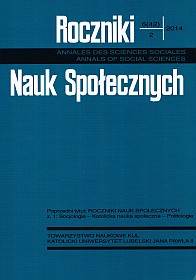Phases of the Demographic Change in Poland
Abstract
This article discusses a long-term demographic perspective for Poland. Irrespective of their diversified nature, the changes in the demographic structure of the Polish society have been evolutionary and took place in a phased manner. Starting with an early stage, when the birth rate was high, and ending in a situation where the number of newly-born children cannot make up for high mortality rate. It took over 200 years for Poland to move from phase I to V. The evolution has been strictly connected with the economic development of the country, including its urbanization, industrialization and social modernization. The aggravating population decline in the majority of the European states are about to evoke high-scale migration processes. The inevitable flow of migrants from the underdeveloped and developing parts of the world to Europe, and to EU in particular, will soon become a major social concern. The consequences of population displacements between continents will also affect its economic and political functioning.
References
Bijak J., Kupiszewska D., 2005, Impact of International Migration on Population Dynamics and Labour Force Resources in Europe, Working Paper, t. I, Warsaw: CEFMR.
Blacker C.P., 1947, Stages in population growth, „Eugenics Review”, t. XXXIX, s. 88-101.
Buzek J., 1915, Pogląd na wzrost ludności ziem polskich w wieku XIX, Kraków: Centralne Biuro Wydawnictw NKN.
Dziewoński K., Kosiński L., 1967, Rozwój i rozmieszczenie ludności Polski w XX wieku, Warszawa: Państwowe Wydawnictwo Naukowe.
Eberhardt P., 2002, Nowe tendencje w ruchu naturalnym ludności Europy w ujęciu geograficznym, „Przegląd Geograficzny”, t. LXXIV, z. 2, s. 175-198 (Warszawa).
Eberhardt P., 2007, Problematyka demograficzna Polski, „Roczniki Nauk Społecznych”, t. XXXV, z. 1, s. 25-42 (Lublin).
Gawryszewski A., 2005, Ludność Polski w XX wieku, Monografie, t. V, Warszawa: IGiPZ PAN.
Gieysztorowa I., 1964, Badania nad historią zaludnienia Polski, „Kwartalnik Historii Kultury Materialnej”, nr 3-4, s. 523-562 (Warszawa).
Historia Polski w liczbach. Ludność. Terytorium, Warszawa: GUS 1993.
Janczak J.K., 1994, Statystyka ludności Królestwa Polskiego w drugiej połowie XIX w., Przeszłość demograficzna Polski. Materiały i studia, t. XIX, Warszawa, s. 47-116.
Jelonek A., 1957, Ruch naturalny ludności w Polsce w latach 1947-1955, Dokumentacja geograficzna, z. VI, Warszawa: IGiPZ PAN.
Jelonek A., 1992, Ruch naturalny ludności w Polsce w latach 1948-1988, Zeszyty Naukowe Uniwersytetu Jagiellońskiego. Prace geograficzne, z. 92, Kraków: Uniwersytet Jagielloński.
Kaa D.J. van de, 1987, Europes Second Demographic Transition. Population Bulletin, 42, 1, Population Reference Bureau Inc., Washington.
Kaa D.J. van de, Lesthaeghe R., 1986, Bovolking: groei en Krimp. Twee demografische tansities, Deventer: Van Loghum Slaterus.
Kosiński L., Jelonek A., 1960, Geografia zaludnienia i osadnictwa, Kraków: Uniwersytet Jagielloński.
Krzyżanowski A., Kumaniecki K., 1915, Statystyka Polski, Kraków: Skład Główny G. Gebethnera.
Landry A., 1909, Les trois théories principales de la population, „Revue Scientia”, t. VI (Paris).
Landry A., 1934, La révolution démographique, Paris: Sirey.
Madajczyk Cz., 1970, Polityka III Rzeszy w okupowanej Polsce, Warszawa: Państwowe Wydawnictwo Naukowe.
Michalewicz J., 1979, Elementy demografii historycznej, Warszawa: Państwowe Wydawnictwo Naukowe.
Notestein F.W., 1945, Population. The Long View, w: T.W. Schultz (red.), Food for the World, Chicago: Chicago University Press, s. 37-57.
Okólski M., 2004, Demografia. Podstawowe pojęcia, procesy i teorie w encyklopedycznym zarysie, Warszawa: Wydawnictwo Naukowe SCHOLAR.
Piesowicz K., 1988, Ważniejsze zmiany w zaludnieniu ziem polskich w czasie II wojny światowej, „Studia Demograficzne”, nr 3 (93), s. 77-123 (Warszawa).
Sauvy A., 1952/1954, Théorie générale de la population, Paris: PUF.
Szukalski P., 2007, Potencjał ludnościowy Europy i jej zmiany w perspektywie do roku 2050, Europa w perspektywie roku 2050. Warszawa: Komitet Prognoz „Polska 2000 plus”.
Thompson W.S., 1929, Danger Spots in World Population, New York: Alfred A. Knopf.
Vielrose E., 1961, Elementy ruchu naturalnego ludności, Warszawa: Szkoła Główna Planowania i Statystyki.
Witthauer K., 1958, Die Bevölkerung der Erde, Gotha: Hermann Haack.
Wittthauer K., 1959, Zur geographischen Differenzierung der Bevölkerungsdynamik, Petermanns Geographische Mitteilungen, t. C0III, nr 4, s. 289-298, Gotha.
Wojtun B., 1984, Zmiany rodności i umieralności ludności Polski centralnej w XIX i XX w., „Przeszłość Demograficzna Polski”, t. XIV, s. 147-151 (Warszawa).
World Population Ageing 2007, New York: United Nations 2007.
Zagadnienia demograficzne Polski i ruch naturalny ludności w latach 1895-1935, red. S. Szulc, Warszawa: GUS 1936.
Załęski W., 1876, Statystyka porównawcza Królestwa Polskiego. Ludność i stosunki ekonomiczne, Warszawa: Wydawnictwo J. BERGER.
Załęski W., 1900, Królestwo Polskie pod względem statystycznym, cz. I, Warszawa: Skład Główny Księgarni Jana Fiszera.
Copyright (c) 2014 Roczniki Nauk Społecznych

This work is licensed under a Creative Commons Attribution-NonCommercial-NoDerivatives 4.0 International License.


